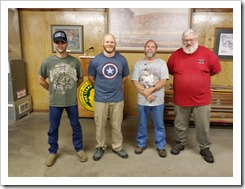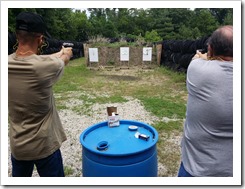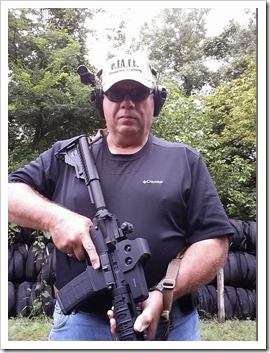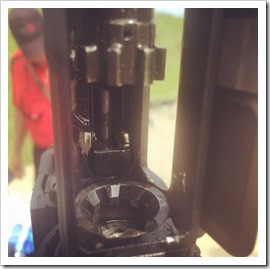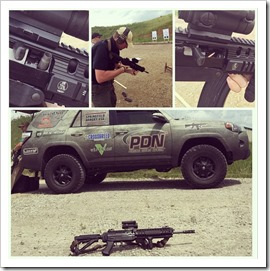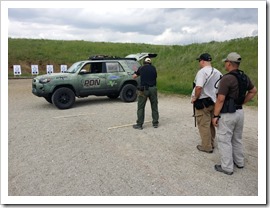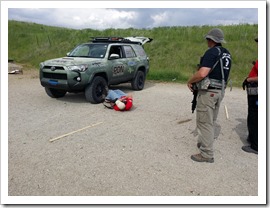All things come to an end . . . and so does the development of coursework. I – and another trainer friend – have been developing/working/refining three individual pieces of coursework over about the past 3 years. We have finally reached the “It’s a WRAP!” stage this past weekend and I thought I’d share with you a general over view, an AAR for the final training weekend and some thoughts on training teams and associations in general.
Why develop your own coursework? For the two of us there were a number of specific reasons. First – most handgun courses are being conducted in states to fulfill a broad range of training requirements imposed by individual states. Depending on the state these may be fully non-existent due to a state being a “Constitutional Carry” state or a state may also require a minimum “safety” course requiring a minimum amount of classroom time or perhaps an on-line course of some type, that happens to be the case in my state of Iowa. Or, you may live in a state that requires a lengthy set of course work such as Illinois. In these cases custom coursework seems to be the standard evolution of things.
Most folks looking to get their Concealed Carry Permit (or whatever the heck your particular state calls it) have a fondness for going the “least training” route. I get it. I am fully on board with the whole idea of Constitutional Carry . . . but I am also not an idiot. I fully encourage new shooters to take coursework to make sure they understand the concept of becoming a defensive shooter, the gear they need, that it takes to “run the gun”, equipment they need, range gear they need and finally – course work that will actually move them from a sports shooter to a defensive shooter.
So why “my” coursework – there’s tons of stuff out there. Yep, I agree. But – that said – and knowing I am likely to get these folks only once for training, I saw there was a lack of what I describe as “Foundational” course work. Hence the migration toward our finally step in the evolution of this particular set of coursework – “Foundations of Defensive Pistol”.
Past that, there is the “next level” in a set of defensive shooting coursework whose focus is to move the defensive shooter into the realm of an individual who carries whenever/wherever it is legally possible. That task fell to another trainer – Chris Shoffner - who I have worked and trained with since I met him during a NRA Training Counselor Workshop. He had been teaching a defensive pistol set of coursework that we took as the foundation and refined it even more – building on the “Foundations” course.
Finally, specific shooting drills were extracted and combined in our “Basic Defensive Handgun Shooting Skills” course. This is a range only set of coursework and focused entirely on developing the defensive shooter’s skill set.
While it is simple to just “develop shooting classes”, creating solid coursework that has clearly defined goals and a logical path from beginning to end is not so simple. What helps with that is your willingness as an instructor to present your work to your peers – other instructors, as well as a sprinkling of new shooters. That has been part of this rather intense exercise over the past 8 months or so. I related much of this in earlier posts. The biggest challenge for the typical Type A+++++ instructor personality . . . LISTEN to what your “students” have to say in the AARs and then honestly evaluate the feedback.
The challenge for the typical Type A+++++ instructor acting as a guinea pig – be honest with your feedback and evaluate the coursework as presented . . . and not as you would have done it.
Both myself and Chris have been blessed with training peers that met the “open and honest” criteria and we took full advantage of the teaching opportunities and the resulting feedback. It’s been an interesting process.
Review - Defensive Handgun Training - get out of your box
Training - Course Development Part 2
Training - Course Development Part 3
But, as with all things, an “end” is reached. This past weekend – June 20-21, was that end and final review. Let me pop in here and say a few words about “training teams” and “training associations”. It is very difficult for a single instructor to cover all possible bases when developing and teaching defensive shooter coursework. If you look at all the big “names” in the industry you notice quite quickly they are surround by and part of a “team” whose focus is in delivering the best possible product to the customer they can. I would encourage you to develop your team and use them in both the development and teaching of your coursework.
Training Associations are a bit of a horse of a different color. These are groups of like-minded instructors with a single goal in mind . . . to become better, more educated shooting instructors. Perhaps the best example I know of to date is the annual Rangemaster Tactical Conference I attended last year. I did a review of that in my post Review - Rangemaster Tac Conference 2015. It covered a broad range of both classroom and shooting range material. While not an association per say, the content of the Tactical Conference is exactly what I see the purpose of Training Associations being – providing its members with ongoing training and updated information on everything from firearms to training concepts. These associations can also lead to coursework that is continually evaluated, updated and taught in such a way to insure a high degree of quality of the “product”.
Which finally brings me to the AAR of the training weekend . . .
It’s a Wrap!
The weekend was hosted by Armed Missouri, Inc. of Mt. Sterling, MO. Our host was Chris and Nic Shoffner. They have a great range, good (air conditioned) classroom space and standard range gear that allowed for easily configuring a variety of shooting drills.
Also in attendance was . . .
Annette Chapman of Pistol Prep Academy of Atlanta, Il
Timothy Jett of Armed Patriot Defense of St. Charles, MO
Kendall Inman of Brothers N Arms of Salem, MO
Erv and Roxey Rowley of Take Time To Play of Mesa, AZ.
The purpose of the weekend was simple . . . break down different lessons and drills of both the “Foundations of Defensive Pistol” and “Essential Defensive Pistol” and then teach them to each other. Each instructor got 2 drills and a lesson to teach along with all lesson material, instructors manual and power points if appropriate. All of us were told to come ready to teach our specific course material. So, while one instructor was teaching – all others were shooting the drills. Honestly I opted out to film all lessons and range drills. Between Nic and myself we have nearly 12 hours of video for review by all those attending.
We were fortunate we had a dry weekend but to say it was hot and humid would be a profound understatement. Saturday we began at 8AM, I started with a lecture lesson meant to move new shooters from the idea of sports shooting to a mindset of a defensive shooter. From there each of the other instructors taught 2 shooting drills each.
Let me take a moment to focus on how profoundly important it is for instructors who are going to be teaching the same material within their own organizations to gather and teach it to each other. Working on a range together helps cement a personal bond between the instructors as well as insuring we are all teaching the range work the same way. While words in an instructor’s manual can help direct an instructor’s methods – nothing beats face-to-face time with each other and hands on instruction so we are all moving in lockstep before we all begin teaching it to our respective customers. This is why virtually all major training organizations have specific steps in place to make sure everyone is on the “same page”. When you develop your own coursework for your own organization remember, there are simply no shortcuts to the process – period.
Day one was hot, sweaty but just about perfect in length with all of us off the range by 3:30-ish PM and at Chris’s house clean and showered for an evening of burgers, brats, fixins and good conversation. It was a nice way to finish the day.
Day 2 began with the very real threat of heavy rain that was nice enough to slide to our south. While cooler temps prevailed for most the morning – the afternoon was quite toasty.
The first two lessons of the day were presented by Chris and Nic in their classroom. I gotta say the air felt nice but it was also gratifying to see the classroom material we had been working on for so long flowed really well. After that the remaining 5 lessons were all range work with over 20 drills meant to move a shooter up through the process of drawing and engaging a threat from concealment. Again, a very busy day with no lunch breaks since many were headed home with one flying to Arizona and me faced with a 6-ish hour drive.
Once the drills were completed, there was a debrief of the weekend and the expectation that each individual will write a comprehensive AAR. For me, there were a number of take-always . . .
Gathering together in a single spot to run the coursework with each other was simply a “have too”! There were just too many details to cover that just needed to be experienced – not just talked about or written about. Face to face range work was a must.
We all had things to learn from each other. Until this weekend we all had taught in our own little “bubble”. There is a real issue with an instructor being so far in their own “forest” that the “trees” of doing some things better or differently simply can’t be seen. Again, a training weekend with each other was of tremendous benefit to get us all on the same page.
Directness, honesty and a willingness to risk your own ego allows a training team to grow very quickly. When we reviewed our experiences of the very first range drills to the final drill – the changes in capabilities of each instructor was clearly visible. By teaching and sharing with each other – real progress was made again with the intent of getting us all on the same page.
Everyone “screwed the pooch” on a drill once in a while. And we all learned from it. I had a rather spectacular double feed on the final drill, my Glock 17 being virtually locked up tight. Other that having to recognize that I was, at that moment, a “dead man walking” – I had a real curiosity as to WHAT THE HELL!!! We finally extracted the locked rounds and I threw them in my pocket. Once home I measured them only to find one substantially out of spec . . . it was significantly longer than it should have been. This was a commercially purchased round from a new ammunition manufacturer here in Iowa. Honestly their rounds have not performed well and I suspect I will be moving back to some of my old favorites for ball ammunition. I like the idea of supporting a manufacturer from my state . . . but it’s gotta run in my gun.
There will be continued value in our gathering together – which we determined we would do semi-annually.
“Doing it right” takes time and commitment on the part of the developers. As many times as we wished we could just “punch the button” and begin teaching the material, it was obvious by the weekend’s end that the time we had spent – including this final ‘training conference” were well worth it. I would encourage you, should you go down this route, to take your time, do the work, seek comprehensive feedback from your peers all to insure you will be happy with your final set of coursework.
If anyone reading this is interested in one of us coming to your area to present this coursework, drop a note. There will be a few more announcements in the very near future to do some final “knitting” of this process so the coursework will be available in the Midwest – or farther for that matter. But the development is done and final . . .
So there you have it . . . IT’S A WRAP!!









































